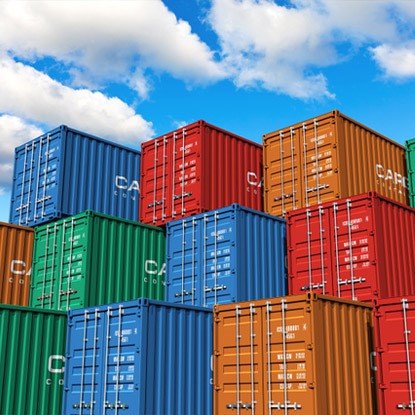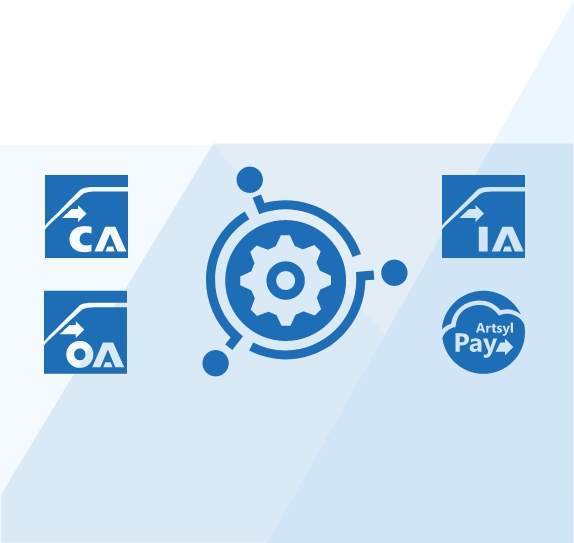In today’s fast-paced eCommerce landscape, efficiency reigns supreme. However, managing a high volume of orders can quickly lead to logistical chaos and rising fulfillment costs. Enter order consolidation, a powerful order management strategy that streamlines order processing and saves businesses valuable time and money.
This article explores order consolidation strategies. We’ll define the concept, outline the key steps involved, and share best practices to help you transform your fulfillment process. You will learn:

Optimize Your Supply Chain Today
Discover how Artsyl OrderAction can streamline your order consolidation process, reducing costs and improving efficiency. Start your free trial now and see the difference automated order management can make!
What Is Order Consolidation?
Order consolidation is a supply chain management practice where multiple smaller orders are combined into a single, larger shipment. This approach is commonly used to enhance efficiency, reduce transportation costs, and improve logistics operations.
Why Consolidate Orders?
By consolidating orders, businesses can take advantage of economies of scale, leading to lower shipping costs per unit. This is particularly beneficial when shipping costs are a significant portion of total expenses. Also, fewer shipments mean less fuel consumption and lower carbon emissions, contributing to more sustainable business practices.
Consolidation can help in better managing inventory levels by reducing the frequency of shipments and aligning delivery schedules more effectively. At the same time, customers may experience faster delivery times and fewer delays when orders are managed and shipped more efficiently.
Last but not least, order consolidation simplifies logistics by reducing the number of shipments, thus minimizing handling, paperwork, and potential for errors.
Order Consolidation: Examples of Use
- Retail Industry: A retailer consolidates orders from various stores into a single shipment to a distribution center, reducing overall shipping costs.
- eCommerce: An online retailer combines multiple customer orders into one shipment to optimize delivery routes and reduce packaging costs.
- Manufacturing: A manufacturer consolidates raw material orders from different suppliers into one delivery, improving production scheduling and reducing lead times.
Order consolidation is a strategic practice that, when executed effectively, can significantly enhance a company’s logistics operations, reduce costs, and support sustainability goals.
Enhance Operational Efficiency
Tired of dealing with fragmented orders and high shipping costs? Let OrderAction automate your order data capture, ensuring smoother operations.
Book a demo now
Key Steps in Order Consolidation
Order consolidation, whether for personal shopping or business fulfillment, involves a strategic approach to combining multiple orders into fewer shipments. Here are the key steps to achieve this efficiently.
Define Your Consolidation Criteria
- Minimum order value: Set a minimum order value before considering consolidation for smaller purchases.
- Delivery location: Group orders going to the same destination for combined shipping.
- Product compatibility: Ensure products can be safely packaged together without damage.
- Delivery timeframe: Consolidate based on acceptable delivery windows for customers or prioritize rush orders.
Implement Order Cut-off Times
Establish clear deadlines for orders to be eligible for a specific consolidation window. This helps with planning and scheduling for efficient picking and packing.
Leverage Order Management Technology
Utilize an order management system (OMS) to track orders, identify consolidation opportunities, and generate packing slips. Inventory management software can help ensure sufficient stock for consolidated orders. We will discuss its benefits in more detail.
Optimize Picking and Packing
Strategically organize your warehouse or picking area to facilitate efficient picking of multiple orders. Make sure to use appropriate packing materials to ensure all items are secure during transport.
READ MORE: Cash Flow and Accounts Payable: What You Need to Know
Communicate Effectively
Proactively inform customers about the benefits of order consolidation and potential delays due to combined shipping. You should also offer clear order tracking information for consolidated shipments.
Monitor and Improve Your Order Consolidation Strategy
Track consolidation metrics like cost savings, efficiency gains, and customer satisfaction.
Analyze data to identify areas for improvement and refine your consolidation strategy continuously.
By following these key steps, you can establish a robust order consolidation process that saves time, reduces costs, and improves the overall customer experience. Let’s explore some additional best practices to further optimize your consolidation efforts.
Simplify Your Logistics
Transform your logistics with Artsyl OrderAction’s intelligent order data capture capabilities. Learn how our intelligent solution can help you manage inventory better and deliver faster. Schedule a consultation today!
Book a demo now
How Technology Helps with Order Consolidation
Order management software is the main technology utilized for order consolidation. In fact, order management software (OMS) is the central nervous system for order consolidation, but it’s not the only technology that plays a role. Here’s a detailed look into how OMS and other technologies work together to streamline order consolidation.
Order Management System (OMS) Core Functionality
An OMS acts as a central hub, integrating data from various sources like online stores, marketplaces, and inventory management systems. The OMS identifies orders that meet your consolidation criteria (e.g., same destination, exceeding minimum value).
The order management system automates tasks like generating consolidated packing slips, updating inventory levels, and even calculating optimal shipping options for combined orders.
Inventory Management Software
Real-time inventory data is crucial for consolidation. Inventory management software ensures sufficient stock is available to fulfill consolidated orders. It can generate alerts for low stock levels, preventing delays or order splitting due to unavailable items.
Warehouse Management System (WMS) (if applicable):
For businesses with physical warehouses, a WMS plays a key role. It optimizes picking routes for consolidated orders, minimizing travel time within the warehouse and streamlining the fulfillment process.
Additional Technologies for Order Consolidation Success
By integrating these technologies, businesses create a powerful ecosystem for order consolidation. The OMS orchestrates the process, while other software tools provide vital data and functionalities for smooth execution. This holistic approach allows businesses to automate manual tasks, minimize errors, and achieve significant efficiency gains throughout the consolidation process.
Transportation Management Systems (TMS)
TMS uses sophisticated algorithms to optimize routes, consolidate orders, and schedule shipments efficiently. It ensures that the most cost-effective and time-efficient transportation options are chosen. Also, TMS provides real-time visibility into shipments, allowing for dynamic adjustments to consolidation plans based on current conditions and demands.
Warehouse Management Systems (WMS)
A warehouse management system (WMS) is software that manages and controls warehouse operations from the moment goods enter a warehouse until they move out. It includes functionalities for inventory tracking, order picking, packing, shipping, and receiving.
Warehouse management systems help optimize warehouse space, streamline workflows, and reduce errors in order fulfillment. By providing real-time visibility into inventory levels and warehouse activities, a WMS improves efficiency and accuracy. It also supports advanced processes like automated picking and barcode scanning to enhance productivity.
Demand Forecasting Tools
This software utilizes historical data and trends to predict future order volumes, allowing businesses to plan consolidation strategies proactively. Inventory optimization ensures that the right amount of inventory is available for consolidation, minimizing the need for multiple smaller shipments.
Enterprise Resource Planning (ERP) Systems
ERP systems integrate data from various departments, providing a holistic view of order and inventory status. This integration helps in identifying consolidation opportunities across the supply chain. ERPs automate order processing and fulfillment, making it easier to group orders for consolidation.
DISCOVER MORE: Cost Accounting and Financial Reporting in ERP
Advanced Analytics and Artificial Intelligence (AI)
AI and machine learning algorithms can analyze large datasets to identify patterns and trends that suggest optimal consolidation opportunities. AI order optimization systems provide insights and recommendations for consolidation based on factors like order volume, destination, and shipping costs.
Internet of Things (IoT) for Order Consolidation
IoT devices collect real-time data on inventory levels, shipment status, and environmental conditions, providing the necessary information to make informed consolidation decisions. This improves visibility into the entire supply chain, enabling more precise and timely consolidation efforts.
Automated Guided Vehicles (AGVs) and Drones
AGVs and drones can automate the movement of goods within warehouses and distribution centers, facilitating the consolidation process by quickly bringing together different items for combined shipments. This increases the speed and accuracy of the consolidation process, reducing lead times and errors.
Customer Relationship Management (CRM) Systems
CRM systems provide insights into customer orders and preferences, enabling businesses to anticipate order patterns and plan consolidation strategies accordingly. This improves communication with customers regarding order status and consolidation benefits, ensuring transparency and customer satisfaction.
Barcode Scanners and Labelling
These devices speed up picking and packing by scanning barcodes on products and consolidating orders. As part of shipping integration platforms, you can connect your order management system with shipping carriers for efficient label generation and tracking of consolidated shipments.
FIND OUT MORE: Sales Order vs. Purchase Order: 10 Differences
Benefits of Technology-Enhanced Order Consolidation
By optimizing routes and consolidating orders, businesses can significantly reduce shipping and handling costs. Automation and advanced analytics streamline the consolidation process, reducing manual labor and increasing throughput.
At the same time, technology solutions can easily scale with business growth, accommodating increasing order volumes and complexity, while enhanced visibility and real-time tracking ensure timely deliveries and improved customer satisfaction.
Technology plays a pivotal role in order consolidation by providing the tools and insights needed to optimize the entire process, from inventory management to shipment tracking, ultimately leading to greater efficiency, cost savings, and customer satisfaction.
Reduce Shipping Hassles Instantly
Cut down on transportation delays by consolidating your orders with OrderAction smart order data capture. Our technology ensures smooth processing even for the most complex orders. Try it out and see for yourself!
Book a demo now
Understanding Order Consolidation in More Detail
How Important Is Demand Forecasting?
Demand forecasting is the process of predicting future customer demand for products or services based on historical data, market trends, and other variables. It helps businesses plan inventory levels, production schedules, and supply chain activities more effectively.
Accurate demand forecasting reduces the risk of overstocking or stockouts, leading to better inventory management and customer satisfaction.
Advanced demand forecasting uses statistical methods, machine learning, and AI to enhance prediction accuracy. This proactive approach enables businesses to respond swiftly to market changes and optimize their operations.
What Is the Role of Enterprise Resource Planning (ERP)?
Enterprise resource planning (ERP) is an integrated software platform that manages a company’s core business processes, including finance, HR, manufacturing, supply chain, and services.
ERP systems provide a centralized database and standardized processes to improve data accuracy and operational efficiency. They facilitate information flow between departments, enabling better decision-making and collaboration.
ERP solutions often include modules for order processing, inventory management, and customer relationship management, among others. By consolidating disparate systems into one platform, ERP enhances visibility and control over the entire organization.
What Is Advanced Analytics in Order Consolidation?
Advanced analytics involves using sophisticated techniques such as machine learning, predictive modeling, and data mining to analyze complex data sets and extract valuable insights. It goes beyond traditional business intelligence by identifying patterns, trends, and relationships in data that are not immediately apparent.
In the context of order consolidation, advanced analytics can optimize routing, forecast demand, and identify consolidation opportunities. These insights help businesses make data-driven decisions that enhance efficiency and reduce costs.
By leveraging advanced analytics, companies can stay competitive and respond more effectively to market dynamics.
Why Use Artificial Intelligence (AI) in Order Consolidation?
Artificial intelligence (AI) refers to the simulation of human intelligence in machines programmed to think, learn, and perform tasks autonomously. AI technologies, such as machine learning and natural language processing, enable systems to improve their performance over time based on data.
In order consolidation, AI can automate decision-making processes, optimize routing, and enhance demand forecasting. AI-driven solutions can quickly analyze vast amounts of data to identify the most efficient consolidation strategies.
By implementing AI, businesses can achieve greater efficiency, cost savings, and accuracy in their logistics operations.
What is the Role of Cloud Computing?
Cloud computing involves delivering computing services, including storage, processing, and software, over the internet (the cloud). Cloud-based solutions offer scalability, flexibility, and cost-efficiency, making them ideal for businesses of all sizes.
In order consolidation, cloud computing enables real-time data sharing, collaboration, and access to advanced analytics tools. Cloud platforms can integrate with various systems, providing a unified view of operations and facilitating efficient consolidation.
By adopting cloud computing, businesses can enhance their agility, reduce IT costs, and improve their overall performance.
How Is Blockchain Technology Related to Order Consolidation?
Blockchain technology is a decentralized, distributed ledger system that securely records transactions across multiple computers. It ensures transparency, immutability, and traceability of data, making it suitable for secure and verifiable record-keeping.
In logistics, blockchain can enhance order consolidation by providing a transparent and tamper-proof record of shipments, contracts, and transactions. Smart contracts on the blockchain can automate and enforce consolidation agreements, reducing administrative overhead.
By implementing blockchain, businesses can improve trust, reduce fraud, and streamline their supply chain operations.
Boost Customer Satisfaction
Deliver on time, every time with Artsyl OrderAction’s efficient order data capture. Improve your customer satisfaction and retention rates by ensuring timely and accurate order processing.
Book a demo now
Final Thoughts
Order consolidation isn’t just a cost-saving tactic; it’s a strategic advantage. By optimizing your fulfillment processes, you can improve customer satisfaction, reduce your environmental footprint, and free up resources to focus on core business activities.
Ready to unlock the true potential of order consolidation? Implement the strategies outlined in this blog and watch your fulfillment operation soar.
Remember, a few simple steps can lead to a significant increase in efficiency and profitability. So, start consolidating, and experience the power of streamlined order fulfillment.




 What Is Order Management Software
What Is Order Management Software Order Processing. How it Works & Key Methods
Order Processing. How it Works & Key Methods Order to Cash Process
Order to Cash Process Order Management System: A Buyer’s Guide
Order Management System: A Buyer’s Guide Purchase Order Confirmation: What Is It and How to Send
Purchase Order Confirmation: What Is It and How to Send Order Processing in Manufacturing Operations
Order Processing in Manufacturing Operations